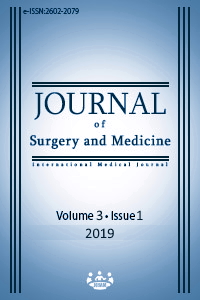Which one is the first choice for rapid ventricular rate atrial fibrillation in emergency department: Metoprolol or Diltiazem? A randomized clinical trial
Keywords:
Atrial fibrillation, Diltiazem, Metoprolol, Rate controlAbstract
Aim: Atrial fibrillation (AF) is the most common cardiac arrhythmia managed by emergency physicians. Primary goals of treatment are hemodynamic stabilization, ventricular rate control, and prevention of embolic complications. The aim of this study is to compare the drug responses of the patients who presented to the ED with AF with rapid ventricular response (AFRVR), their need for the second dosage and echocardiographic parameters.
Methods: This is a prospective, single blind, randomized study. AFRVR patients were randomized and first group was given intravenous 0.25 mg/kg diltiazem as the calcium channel blocker; the second group was given intravenous 5 mg metoprolol. The vital findings and the clinical data of the patients in the 0, 2nd 5th, 15th and 30th minutes were recorded after each treatment. After the initial dosing, the patients having heart rate <110 beat/min in the 30th minutes were regarded as responders to the initial treatment. Nonresponders took second dosage of the same drug. After the rate control of all patients, a cardiologist performed the transthoracic echocardiography (TTE)'s of all participants.
Results: Fifty of the patients were given diltiazem, 50 of them were given metoprolol. 45 of them (45%) had no first dose response; whereas 55 (55%) of them had. The rate of incidence for the first dose response in the patients having diltiazem was higher than the patients having metoprolol, which was statistically significant. There is statistically significant difference between rates of the valvular heart disease seen for the patients in responsive /unresponsive groups for both drugs. But diltiazem is more successful in presence of valvular disease than metoprolol.
Conclusion: In this study, we found that diltiazem is more effective in the rate control of AFRVR in emergency department. This study showed that most of atrial fibrillation patients have valvular disease, and diltiazem is more effective than metoprolol in these patients. Ejection fraction, cardiac diameters are important in drug response.
Downloads
References
"2014 AHA/ACC/HRS guideline for the management of patients with atrial fibrillation: a report of the American College of Cardiology/American Heart Association Task Force on Practice Guidelines and the Heart Rhythm Society." Journal of the American College of Cardiology 64.21 2014:e1-e76.
Demircan C, Cikriklar HI, Engindeniz Z, Cebicci H, Atar N, Guler V et al. Comparison of the effectiveness of intravenous diltiazem and metoprolol in the management of rapid ventricular rate in atrial fibrillation. Emergency Medicine Journal. 2005;22:411-4.
Fromm C, Suau SJ, Cohen V, Likourezos A, Jellinek-Cohen S, Rose J, et al. Diltiazem vs. Metoprolol in the Management of Atrial Fibrillation or Flutter with Rapid Ventricular Rate in the Emergency Department.The Journal of emergency medicine. 2015;49:175-82.
AFFIRM Investigators. A comparison of rate control and rhythm control in patients with atrial fibrillation. N Engl J Med. 2002;347:1825-33.
Farshi R, Kistner D, Sarma JS, Longmate JA, Singh BN. Ventricular rate control in chronic atrial fibrillation during daily activity and programmed exercise: a crossover open-label study of five drug regimens. Journal of the American College of Cardiology. 1999;33(2):304-10.
Steinberg JS, Katz RJ, Bren G, Buff LA, Varghese PJ. Efficacy of oral diltiazem to control ventricular response in chronic atrial fibrillation at rest and during exercise. Journal of the American College of Cardiology. 1987;9(2):405-11.
Olshansky B, Rosenfeld LE, Warner AL, Solomon AJ, O'Neill G, Sharma A, et al. The Atrial Fibrillation Follow-up Investigation of Rhythm Management (AFFIRM) study: Approaches to control rate in atrial fibrillation. Journal of the American College of Cardiology. 2004;43(7):1201-8.
Martindale JL, Silverberg M, Freedma, J, Sinert R. β-Blockers versus calcium channel blockers for acute rate control of atrial fibrillation with rapid ventricular response: a systematic review. European Journal of Emergency Medicine. 2015;22:150-4.
Salih S, Showlag MS, Al-Qahtan MA, Taha A, Yousuf M, Abdullah M. Clinical characteristics of patients with atrial fibrillation at a tertiary care hospital in the central region of Saudi Arabia. Journal of Family and Community Medicine. 2011;18:80.
Gudbjartsson DF, Holm H, Gretarsdottir S, Thorleifsson G, Walters GB, Thorgeirsson G, et al. A sequence variant in ZFHX3 on 16q22 associates with atrial fibrillation and ischemic stroke. Nature genetics. 2009;41:876–8.
Watson T, Shantsila E, Lip GY. Mechanisms of thromboge¬nesis in atrial fibrillation: Virchow’s triad revisited. Lancet. 2009;373:155–66.
Kannel WB, Benjamin EJ. Status of the epidemiology of atrial fibrillation. The Medical clinics of North America. 2008;92:17-40.
Darby AE, DiMarco JP. Management of atrial fibrillation in patients with structural heart disease. Circulation. 2012;125:945-57.
Wang TJ, Parise H, Levy D, D’Agostino RB, Wolf PA, Vasan RS, et al. Obesity and the risk of new-onset atrial fibrillation. JAMA. 2004;292:2471–7.
Downloads
- 2498 2597
Published
Issue
Section
How to Cite
License
Copyright (c) 2019 Mehmet Barış Memiş, Rohat Ak, Tuba Cimilli Öztürk, Özge Onur, Özgür Ordu
This work is licensed under a Creative Commons Attribution-NonCommercial-NoDerivatives 4.0 International License.
















